Drought-resistant and productive potato variety Labadia: description and characteristics
If there is a lack of vitamin C, we try to buy more apples and oranges to replenish the missing element in the body. And we don't even suspect that its daily requirement is contained in the fruits of potatoes. 200 g of potatoes, cooked in any form, will enrich the human body with a sufficient amount of this vitamin.
Labadia potatoes, which came to us from Holland, are considered the most fortified product. It will not only satisfy everyone with excellent taste, but also does not require much time and effort to grow.
The content of the article
Characteristics and description
Potato variety Labadia (Labadia) originated in the Netherlands. It is known that the Dutch varieties have won worldwide fame for their high quality products. This variety is no exception. Today it is used not only in the West, but also in Russia. The culture was entered in the State Register of Selection Achievements in 2012.
Difference from other varieties
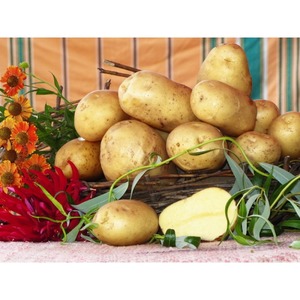
The crop is well adapted to drought, heat-resistant and shows high yields on all types of soil, which, with proper treatment of the seed, can be almost doubled.
It is not surprising that the culture is gaining great popularity among vegetable growers.
Composition, trace elements and vitamins
Unlike other vegetables, potatoes are considered a high-calorie product, since 80% of dry matter is starch. But, despite this, its benefits are undeniable. The increased content of vitamin C and fiber strengthens the immune system and improves intestinal peristalsis.
A ripe vegetable contains the entire complex of vitamin B, including B5 (niacin), folic acid, as well as proteins and carbohydrates (pectin, glucose, fructose and sucrose). Root crops contain potassium and phosphorus salts. The chemical composition is complemented by organic acids: malic, citric and oxalic.
reference... Potato skins contain solanine. It is a poisonous glycoalkaloid, which is especially abundant in sprouted tubers.
Description of the plant
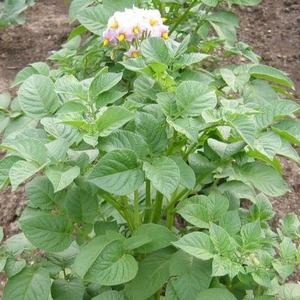
The bush is tall, erect, not spreading, with a powerful, well-developed stem. The leaves are large, light green. When flowering, the bushes are strewn with large white flowers.
Ripening period is medium early, from the moment of emergence to full maturity, 75–85 days pass. Lodging of tops is observed on day 105.
The plant has strong immunity to potato cancer, wrinkled mosaic virus, golden nematode. But the average resistance to late blight and leaf-rolling virus is observed.
Characteristics of tubers
The shape is oval-elongated, the average weight is 100–150 g, the fruits are large, leveled. The peel is creamy yellow with small eyes, the surface is rough. The pulp is pale yellow in color, the taste is good.
Suitable for universal use: cooking, frying, stewing, baking. Potatoes are also used to produce chips, fries and fast foods. When cooking, the fruits can be boiled, so they are not brought to full cooking, they are removed from heat in 3-4 minutes.
The keeping rate is high. Up to 97% of finished products retain their appearance for a long time.Transportation is possible over any distance without loss of taste, so many farmers are interested in growing this species.
The photo shows Labadia potatoes.
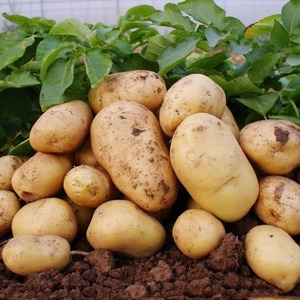
Yield
A big plus of the plant is its survival rate and rich fruiting on any type of soil. Stable figures for this variety are 300–450 c / ha. Although with good care and competent pre-sowing treatment, indicators of 550 c / ha were recorded.
One bush forms 7-10 fruits of almost the same size.
Growing regions
The culture is geographically focused on several regions:
- Ural;
- Volgo-Vyatsky;
- Middle Volga;
- North Caucasian;
- Central;
- Central Black Earth.
Landing dates
Planting dates determine the climatic conditions of the region. This is mainly the end of April or the first days of May. The main indicator is soil temperature not less than + 10 ° C, air temperature - + 16-18 ° C. If heavy rains or return frosts are expected, it is better not to rush to land. Otherwise, you can ruin all the seed material.
To get an early harvest, potatoes are planted under an arc (film), where the necessary conditions are created 2 weeks earlier.
It is interesting! Many gardeners are guided by folk signs that indicate the time of planting. The main ones are: the time when the birch leaves have fully blossomed, and the end of the flowering of the bird cherry.
Advantages and disadvantages
The benefits include:
- survival in any soil;
- unpretentious care;
- drought adaptation;
- increased productivity;
- the possibility of breeding for sale;
- great taste;
- transportation over any distance;
- long-term storage;
- versatility in use.
The disadvantages of the variety include susceptibility to late blight and leaf curling.
Features of planting and growing
Despite the fact that the culture grows and bears fruit on all types of soils, the most favorable acidity for it is in the range of 5.0–6.0 pH. Chamomile, coltsfoot, dandelion and clover will help identify it. Where these herbs are found, potatoes will also be comfortable.
Sowing preparation
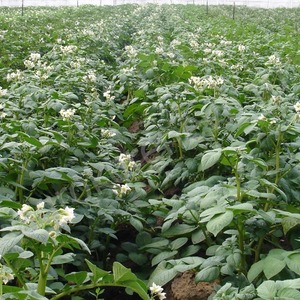
Seed preparation begins in 1 month. First, the tubers are carefully examined and only healthy, light-colored specimens are selected. For 20 days they are left in a bright room for sprouting. Without them, the tubers will not germinate.
Before planting, potatoes are treated with growth stimulants and the fungicide Fitosporin. The drug not only protects the seed from fungal infections, but also strengthens the immune system. As soon as the sprouts reach a length of 2 cm, the tubers are planted in prepared ridges.
Do not forget about the temperature regime. If the soil has not warmed up to + 10 ° C, it is better to wait with planting.
Landing scheme and technology
Planting pattern: 35 cm - the distance between the holes, 70 cm is left between the rows.
The beds are chosen in a sunny, unshaded place. The soil is prepared in advance - 1 month before sowing. It is dug up, humus and wood ash are introduced. Potatoes belong to the nightshade family, which are demanding on fertilizers.
The planting depth is 8–10 cm. When sowing potatoes, the skin of which has a greenish tint, there is no need to be afraid that the seed will be spoiled by rodents. Field mice, which are especially numerous after a hungry winter, usually do not touch such tubers. The solanine contained in the skins of potatoes is poisonous to them.
reference... The green color of the peel indicates an excess of solanine.
Further care for Labadia potatoes
Agricultural technology is simple, the variety does not require increased attention. The main thing is to ensure competent watering and timely feeding.
Watering mode
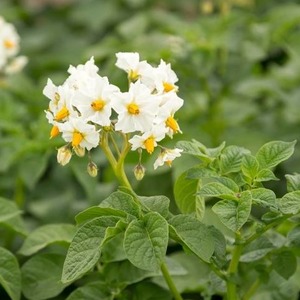
Labadia is a moisture-loving plant, and with sufficient watering, you can harvest a rich harvest... It is limited only in rainy weather, the rest of the time it is watered abundantly from the moment the seedlings reach a height of 6 cm.
Overdrying should not be allowed, a lack of moisture will negatively affect the forming ovaries. Before and after flowering, 40–45 liters of water are consumed per 1 m² to ensure the full development of tubers.
After watering, the soil is loosened and weeded. The roots need a constant supply of oxygen, which is facilitated by loosening the earth. And the presence of weeds leads to plant diseases. In addition, weeds are a favorite habitat for many pests.
Hilling is carried out three times per season. Huddle high to protect the tubers from the sun's rays, which can turn green from the sun. As soon as the bush grows to 15 cm, the first hilling is carried out. The second is after 3 weeks, and the last procedure is before flowering.
reference... Hilling is the raking of soil from row spacings to the stalks of the seedlings.
Top dressing
After the first hilling, the first feeding is carried out. Fertilized with urea - 5 g per 10 l of water. 0.5 liters are consumed for each seedling.
The second time is fed after 2 weeks. The aisles are spilled with chicken droppings in a ratio of 1:10.
The third time is fertilized at the time of flowering. For the early formation of tubers and ripening, seedlings are fed with a full range of minerals with an emphasis on the content of phosphorus and potassium.
Disease and pest control
In the description of the Labadia potato variety, it is said about its immunity to some dangerous diseases and susceptibility to late blight. The latter belongs to fungal diseases, spreads quickly and destroys up to 70% of plantings.
Simple preventive measures will help protect seedlings from late blight:
- regular moderate watering;
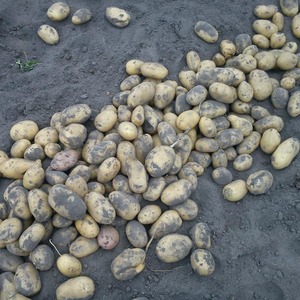
- humidity level control;
- loosening and hilling;
- weed removal;
- pre-sowing treatment of tubers.
During growth, the bushes are sprayed with "Fitosporin". It is used not only for prevention, but also for the treatment of diseased plants.
Labadia is susceptible to attacks by pests, the main of which is the Colorado potato beetle. In order to prevent him from quickly multiplying and spoiling the harvest, it is enough to inspect the bushes daily for the presence of insects. The larvae laid by the female Colorado potato beetle are located on the back of the leaves. They are collected by hand, just like adults.
Another uninvited guest in the garden is the potato moth. This is a butterfly, from the larvae of which plants and tubers suffer. To prevent its appearance, it is enough to carry out high hilling. The plants themselves are sprayed with "Di-68" insecticide.
Growing difficulties
It follows from the characteristics of Labadia potatoes that there are practically no difficulties during the growing season. It can be planted in any soil, the harvest will be stable and rich. The photo shows the uniformity and alignment of the fruits. It remains only to recall the need to comply with the rules of crop rotation. This will preserve the fertility of the soil, increase the immunity and productivity of plants.
It is not recommended to plant potatoes in the place where crops from the nightshade family previously grew: peppers, eggplants and tomatoes. They absorb the same substances from the soil and suffer from the same diseases, the spores of which remain and successfully winter in the ground.
When potatoes are planted in the beds where legumes previously grew, the seedlings not only receive the necessary elements for nutrition, but are also saturated with nitrogen, which accumulates in the soil after peas and beans.
Harvesting and storage
Before harvesting, the tops are mowed, leaving 10-15 cm. Root crops are dug with a pitchfork or a shovel. After harvesting, the potatoes are left in the sun to dry.
If you place the harvested crop under a canopy, drying will take 2-3 days. The potatoes are then sorted by size, put in boxes or bags and stored in a cool dry place.
Advice and feedback from experienced gardeners
Many gardeners who have been growing potatoes on their plots for more than one year willingly share their experience:
- You need to plant the tubers so that a larger number of eyes remain on top.This is necessary for the density of seedlings. When sowing, on the contrary, many shoots will be oppressed.
- You do not need to cut the tubers, it is better to choose smaller potatoes and plant them whole. If, nevertheless, it becomes necessary to cut into pieces, be careful: at least 3 sprouts should remain on each lobe.
Reviews of the plant are positive, many Russians have long fallen in love with the Dutch variety.
Olga, Togliatti: «At the dacha last year I planted 5 kg. I process only from Colorado beetles. I fertilize the plot in the fall and get a rich harvest. For me, this variety is an example of what a real potato should be. I call it nothing but Bud's potatoes. "
Marina, Moscow: “I really like this potato. There are no problems with leaving, the seedlings do not get sick, only you have to fight the Colorado potato beetle. But for me this is not a problem, I take all measures in advance. But there is always delicious, beautiful potatoes on my table, from which you can cook anything you want, from first courses to fries. "
Read also:
Legendary potato variety "American".
Conclusion
Despite the foreign origin, Labadia potatoes have shown themselves to be excellent throughout our country. The crop is high-yielding, has good immunity, quickly adapts to dry summers and takes root well in soil with any composition. And from tubers with excellent taste you can cook absolutely any dish that can satisfy the most whimsical gourmet.